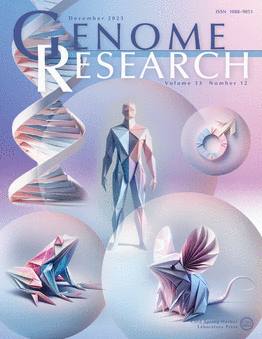高分辨率空间转录组学在固定组织中使用具有成本效益的PCL-seq工作流程
IF 5.5
2区 生物学
Q1 BIOCHEMISTRY & MOLECULAR BIOLOGY
引用次数: 0
摘要
基因表达的空间异质性推动了多种空间转录组学技术的发展。在这里,我们提出了光切割和结扎测序(PCL-seq),这是一种利用光控DNA标记策略应用于组织切片的空间索引方法。PCL-seq利用光可切割的寡核苷酸和连接适配器构建特定感兴趣区域(roi)的转录谱,通过显微镜控制的光照明指定。在冷冻小鼠胚胎中,PCL-seq生成空间对齐的基因表达矩阵并产生高质量的数据,检测到大约170,000个唯一分子标识符(UMIs)和8600个基因(照明直径= 100µm)。此外,PCL-seq与福尔马林固定石蜡包埋(FFPE)组织兼容,成功鉴定了小鼠胚胎FFPE切片中手指和椎骨中数千个差异富集转录本。此外,PCL-seq实现了亚细胞分辨率,正如核室和细胞质室之间的差异表达谱所证明的那样。这些特点使PCL-seq成为冷冻和FFPE组织中具有亚细胞分辨率的空间转录组分析的可访问和通用工作流程。本文章由计算机程序翻译,如有差异,请以英文原文为准。
High-resolution spatial transcriptomics in fixed tissue using a cost-effective PCL-seq workflow
The spatial heterogeneity of gene expression has driven the development of diverse spatial transcriptomics technologies. Here, we present photocleavage and ligation sequencing (PCL-seq), a spatial indexing method utilizing a light-controlled DNA labeling strategy applied to tissue sections. PCL-seq employs photocleavable oligonucleotides and ligation adapters to construct transcriptional profiles of specific regions of interest (ROIs) designated via microscopically controlled photo-illumination. In frozen mouse embryos, PCL-seq generates spatially aligned gene expression matrices and produces high-quality data, detecting approximately 170,000 unique molecular identifiers (UMIs) and 8600 genes (illumination diameter = 100 µm). Moreover, PCL-seq is compatible with formalin-fixed paraffin-embedded (FFPE) tissues, successfully identifying thousands of differentially enriched transcripts in the digits and vertebrae of mouse embryo FFPE sections. Additionally, PCL-seq achieves subcellular resolution, as demonstrated by differential expression profiling between nuclear and cytoplasmic compartments. These characteristics establish PCL-seq as an accessible and versatile workflow for spatial transcriptomic analyses in both frozen and FFPE tissues with subcellular resolution.
求助全文
通过发布文献求助,成功后即可免费获取论文全文。
去求助
来源期刊

Genome research
生物-生化与分子生物学
CiteScore
12.40
自引率
1.40%
发文量
140
审稿时长
6 months
期刊介绍:
Launched in 1995, Genome Research is an international, continuously published, peer-reviewed journal that focuses on research that provides novel insights into the genome biology of all organisms, including advances in genomic medicine.
Among the topics considered by the journal are genome structure and function, comparative genomics, molecular evolution, genome-scale quantitative and population genetics, proteomics, epigenomics, and systems biology. The journal also features exciting gene discoveries and reports of cutting-edge computational biology and high-throughput methodologies.
New data in these areas are published as research papers, or methods and resource reports that provide novel information on technologies or tools that will be of interest to a broad readership. Complete data sets are presented electronically on the journal''s web site where appropriate. The journal also provides Reviews, Perspectives, and Insight/Outlook articles, which present commentary on the latest advances published both here and elsewhere, placing such progress in its broader biological context.
 求助内容:
求助内容: 应助结果提醒方式:
应助结果提醒方式:


